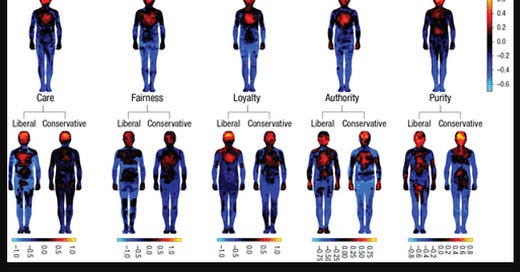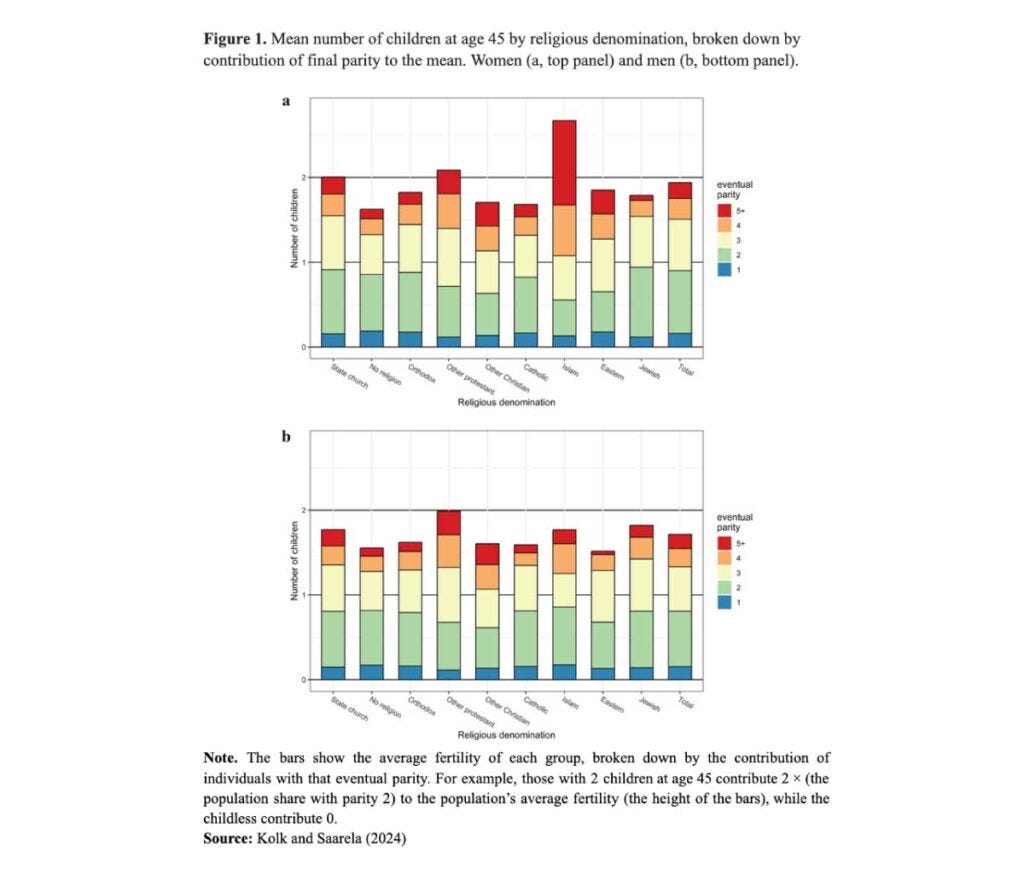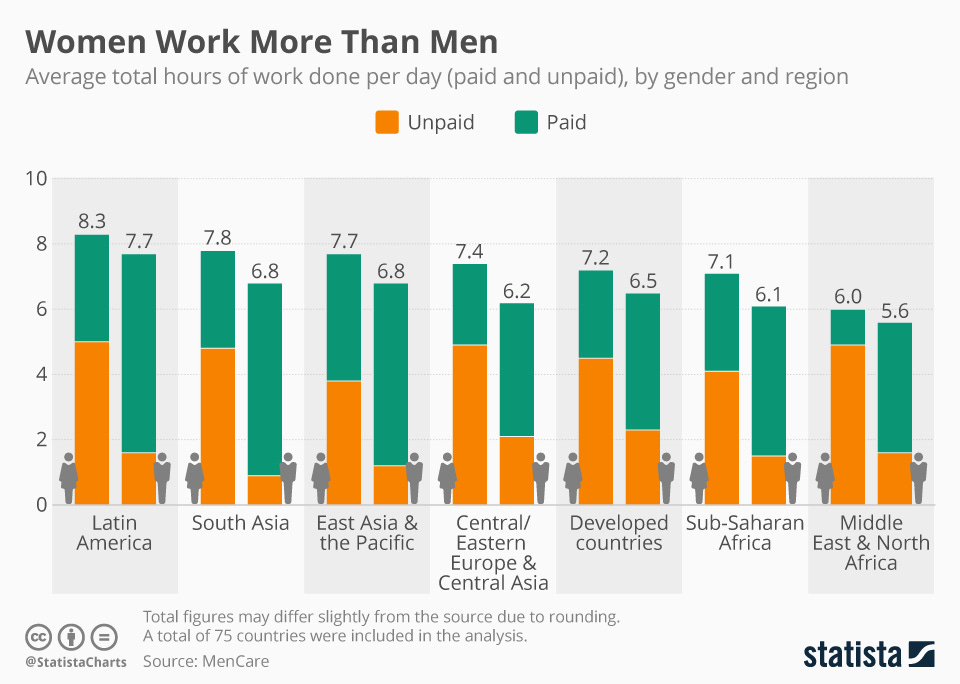
Dutton and Kierkegaard conducted a study1 to prove that conservatives are mentally healthier than liberals. Unfortunately, this study has three flaws:
It uses a European (Finnish) sample, rather than an American one.
It measures mental health according to only two metrics: depression and anxiety.
It measures these factors according to self-reporting: “how did you feel in the last month?”
In comparison with American politics, conservatism and liberalism in Finland are less defined by religiousness and more defined by economics and opposition to immigration.
A study from 2024 found that, not only were Finnish people more secular, but the difference in fertility between religious and non-religious Finns was also smaller than the difference between religious and non-religious Americans. This has implications for a discussion of mental health and political affiliation. Finnish results may not be applicable to America. More research is needed.
In Part XI of this series, I want to draw attention to some ways in which we could get around some of the problems of self-reporting, by evaluating the following:
Brain imaging techniques;
Mental performance:
College attendance;
Number of hours working;
Social behavior;
Drug use;
Suicide Rate;
Caloric intake.
When comparing men with women, women are “mentally healthier” than men in all these metrics, with the exception of caloric intake. Yet women have higher rates of anxiety and depression than men. This indicates that anxiety and depression may, in moderate degrees, provide some kind of “performance enhancing benefit” for regulating pro-social behavior.
brain imaging.
Instead of ascertaining psychological states through self-reporting, it is preferable to assess mental health based on outcomes.
Self-reported psychometrics are problematic. If we ask people, “did you feel strong this month? Did you feel physically healthy this month?” — the self-reported answers would be less accurate than if we made people do pushups and squats and recorded their results. Similarly, true mental health should be tested via performance, not self-reporting.
For example, we could use neuroimaging, as one study did in order to validate a link between liberalism and empathy:
We tested this putative asymmetry using neuroimaging: we recorded oscillatory neural activity using magnetoencephalography while 55 participants completed a well-validated neuroimaging paradigm for empathy to vicarious suffering. The findings revealed a typical rhythmic alpha-band ‘empathy response’ in the temporal–parietal junction. This neural empathy response was significantly stronger in the leftist than in the rightist group.
In order to validate a link between mental illness and leftism, it would be useful to come up with a set of physical tests of mental illness (brain activity, brain scans, brain size, brain shape, or empirical behaviors) to determine mental illness.
mental performance.
What does it mean to behave in a mentally healthy way? By the measurement of anxiety and depression, women are more mentally ill than men. And yet, women are more successful in college; they are less likely to commit crime; they are less likely to abuse drugs and alcohol. In self-reporting, women are more mentally ill than men. But in terms of their behavior and performance, women are much more stable and conformist than men.
I would like to issue the caveat that this does not mean women are superior to men, since stability and conformity inhibit creativity, spontaneity, inventiveness, and risk-taking, all of which are necessary for continued technological progress. But this point must be clarified:
If we are going to call something a disease, or a pathology, that is a value judgment. It is fair to call leftism and rightism different strategies, but it is not valid to call one a pathology, unless we explain the negative impact. This is trivial in the case of physical pathologies; a broken bone inhibits movement without any payoff; the flu decreases energy, alertness, and focus without payoffs. There is no collective benefit to increasing the number of broken bones or flu-like symptoms. But in calling depression and anxiety “pathological,” Dutton and Kierkegaard assume that these behaviors do not have group-level advantages. In a sense, Dutton and Kierkegaard are implying that women are mentally inferior, or more pathological.
Yet women, according to all performance metrics, do better than men. They are more stable, non-violent, and they even work more than men! This should make us question whether depression and anxiety are truly pathological, or whether they are group-selected traits whose purpose is to ultimately increase group conformity and social stability. That is quite different from a broken bone or the flu. Ted Kaczynski might call group conformity and social stability pathological, but Dutton and Kierkegaard (and all other psychologists) should explicitly admit that they are making such a value judgment, rather than implicitly assuming, axiomatically, that these traits are pathological.
Pregnancy and child rearing, for example, causes extreme stress and sleep deprivation. Should a woman who voluntarily becomes pregnant be considered mentally ill? Or, if a man voluntarily works 80 hour weeks, which causes him sleep deprivation and increases biological markers of stress, should he be considered pathological? Individuals who experience greater levels of suffering are not necessarily less “mentally fit” than individuals who are carefree, hedonistic, or low in psychological stress.
Self-reported anxiety and depression inversely correlates at the level of gender with behaviors we would consider “pathological.” Kierkegaard says that women “internalize” their problems while men “externalize” their problems. However, when we look at women’s private, individual, non-social behaviors, they are also more healthy. Women are more likely to practice self-care, including brushing their teeth, and as a result, have less tooth decay. It is in part due to these self-care practices that women live longer lives, while men are more likely to engage in risky and dangerous behaviors.
My criticism of Kirkegaard and Dutton centers on the practice of accepting self-reported self-assessments without considering the possibility of a social signaling effect. There are some areas where self-reported self-assessments are credible. For example, people who admit to being suicidal are much more likely to attempt suicide. But if we want to measure mental health by behavior, not by self-reporting, we should look directly at suicide rates.
anxious about anxiety.
One example where we have found an ability to physically test for anxiety is with the amygdala. The amygdala is a physical structure which, when it is overactive, results in anxiety. We can determine its size and correlate this with increased function. Despite the self-reported increase in anxiety for liberals over conservatives, conservatives actually have a larger amygdala. This indicates that biologically speaking, conservatives are more likely to experience anxiety, but may normalize or justify away this anxiety.
For example, if a liberal experiences anxiety, they will accurately label their experience as anxiety in a self-report. However, a conservative might say, “I’m not anxious,” but simultaneously:
Pray on a daily basis that the country doesn’t collapse;
Worries constantly about the specter of black crime, despite living in a white suburb;
Is afraid that the border is being invaded by Chinese and Iranian terrorists;
Attends a church that preaches that Obama is the Anti-Christ and a pre-trib rapture is coming any day now.
This all sounds like anxiety. However, when asked, a conservative might say, “no, I’m not anxious — because these are all legitimate concerns. I never feel anxious, I feel reasonably concerned.” It’s a labeling error to avoid perceptions of weakness. Conservatives are anxious about being perceived as anxious, and so they lie about feeling anxious (or self-deceive by mis-labeling emotions).
friendship.
According to Jacob Vigil:
Conservatives, being more oriented toward dominance, tend to acquire a larger group of friends and associates than liberals. They are more sensitive to potential threats because there are more people in their orbit, and thus the danger of their being hurt by a duplicitous person is greater. Liberals, being more inward-oriented, have smaller, tighter social groups and thus feel less threatened, which in turn allows them to be more open to unfamiliar experiences.
Conservatives tend to have more relationships which are more superficial, and oriented around common interests like sports. Liberals tend to have deeper relationships which transcend mere hobbies, and tend to be more ideologically cohesive.
Liberals prefer intimacy and trust, while conservatives prefer utility and “going along to get along.” This is why conservatives succeed in group-oriented and goal-oriented social settings, like fraternities and sororities, while liberals succeed in ideologically oriented social settings which require conformity to deeply held beliefs. This may explain why liberals have succeeded in shutting conservatives out of academia: they are better at social networking, excluding, and ostracizing on the basis of ideological conformity. Calling this behavior “pathological,” rather than adaptative, seems like a value judgment rather than an objective psychological measure.
intelligence and obesity.
Mental health is correlated with intelligence:
“Individuals with high g-factors had less general anxiety and post-traumatic stress disorder, were less neurotic, less socially isolated, and were less likely to have experienced childhood stressors and abuse, adulthood stressors, or catastrophic trauma. However, they generally had more allergies… The present study provides robust evidence that highly intelligent individuals do not have more mental health disorders than the average population. High intelligence even appears as a protective factor for general anxiety and PTSD.”2
Liberals have higher intelligence, so on this basis alone, we should assume that liberals are more healthy. This finding is also reinforced if we consider the fact that conservatives are more obese, and intelligence is inversely correlated with obesity.
Besides obesity, we could also examine people’s homes to determine the level of filth and disorder that they tolerate, which is evidence of poor mental health. Unfortunately, it is much more expensive to intrude into people’s homes than to ask for self-reported self-assessments.
suicide.
After a person commits suicide, it’s difficult to ascertain their political affiliation. However, we can look geographically at areas with more conservatism and see what their suicide rates are.
There is evidence that more conservative areas have higher suicide rates:
By 2019, all causes of death were higher in Republican counties, with CVD [Cardiovascular disease] accounting for 27.6 extra deaths per 100,000 and cancer accounting for 17.3 extra deaths per 100,000. Chronic lower respiratory tract diseases, unintentional injuries, and suicide rates also were higher.
From a study in 2017:
Changes in county life expectancy from 1980 to 2014 were strongly negatively associated with Trump’s vote share… Counties in which life expectancy stagnated or declined saw a 10-percentage-point increase in the Republican vote share between 2008 and 2016.
One theory behind Republican suicide is that Republicans have greater access to guns. Another theory is that Republicans have a worse outlook on the future of the country. This theory was backed up by a study from 2022 that found:
All three surveys consistently indicate that around five percent of adults report having suicidal thoughts because of politics—that’s an estimated 12 million people.
This seems to be an exaggeration, because a study from the CDC in the same year found that only 10.6 million Americans have suicidal thoughts. Either the CDC is underestimating the number, or the number of people who had suicidal thoughts due to politics is including multiple years of survey. Still, there is some evidence that politics should be considered a leading cause of suicide, and suicides in Republican areas could be a comorbidity of conservative politics.
According to the CDC, however, rural areas have a 50% higher suicide rate than urban areas. Rural areas tend to be more conservative. In future studies, I would like to see the correlation between politics and suicide adjusted for population density.
Maleness and Suicide
Throughout this series, I have implied that there is a connection between the leftist personality type and the personality difference between men and women. If leftists are more “feminine” than conservatives, then it stands to reason that conservatives are more “masculine.” This might explain why conservatives are more suicidal.
80% of suicides are male. According to Kierkegaard, the psychological effects of ideology on mental health are much less pronounced among women than men. Therefore, suicide is an excellent test of whether self-reported mental health accurately determines psychological outcomes. Kierkegaard found that “extremely liberal” men were 600% more likely to “receive treatment for mental health” than conservative men.
One reason, besides ideological effects, why Republicans might be more suicidal than Democrats is that Republicans tend to be more white, and whites have a higher rate of suicide.
Disability as a performance metric:
When Kierkegaard measured “% with an emotional or mental disability,” an entirely new picture emerged. Extreme conservative men had a higher rate of disability than conservatives, moderates, slight liberals, and liberals. Extreme liberals were nearly 3x as mentally disabled as the general population, but this does not reflect a continuous trend.
According to Kierkegaard’s sample, only 5% of people self-identify as “extremely liberal.” It is true that extreme liberals are more mentally ill than the general population, but this has little bearing on moderate liberals as a whole. And it certainly does not lend credence to the idea that conservatives are more mentally healthy than moderates.
My hypothesis is that anyone who identifies with “extreme” anything is more likely to be mentally ill, and those who are “extremely conservative” are hiding their mental illness by refusing to get help for it. It is plausible that extreme conservatives have similar rates of suicide to moderates and liberals, once we adjust for race and urban density.
Conclusion.
In Part XII, I will consider the problem of self-reporting as it relates to the measurement of pain. I will offer a theory that mental pain (anxiety) can be just as adaptive as physical pain, and mental insensitivity is no more adaptive than a lack of pain response.
2024: Do conservatives really have an advantage in mental health? An examination of measurement invariance: https://www.researchgate.net/publication/383420384_Do_conservatives_really_have_an_advantage_in_mental_health_An_examination_of_measurement_invariance
2022, High intelligence is not associated with a greater propensity for mental health disorders: https://pmc.ncbi.nlm.nih.gov/articles/PMC9879926/









I have heard that seasonal depression might be a very limited form of hibernation